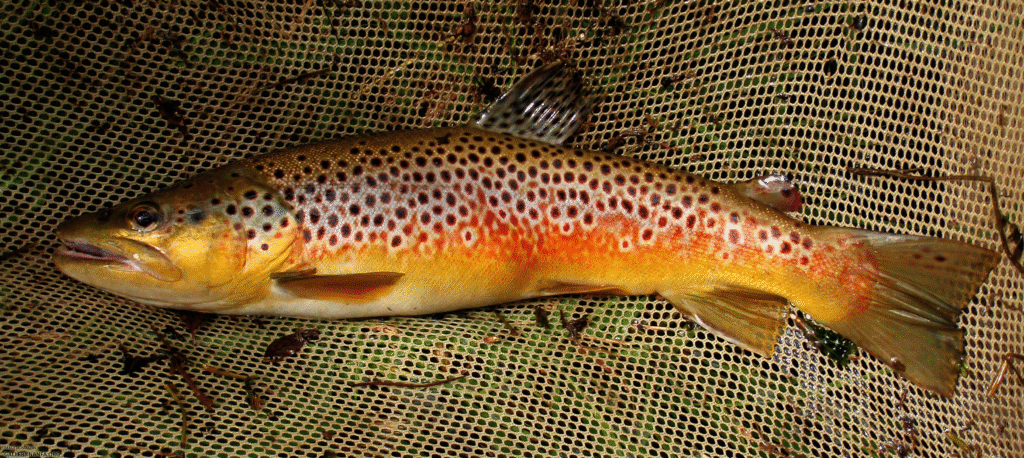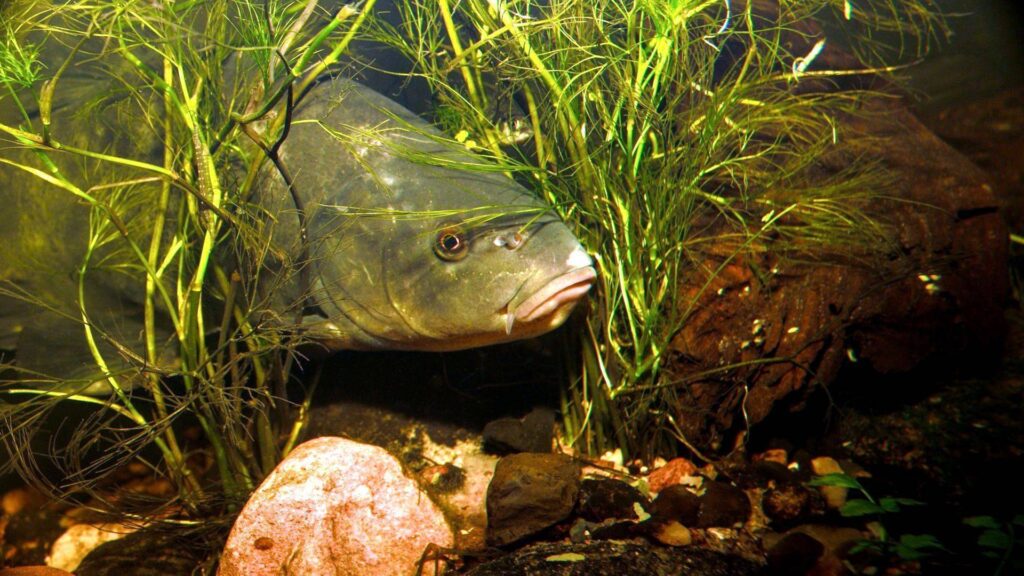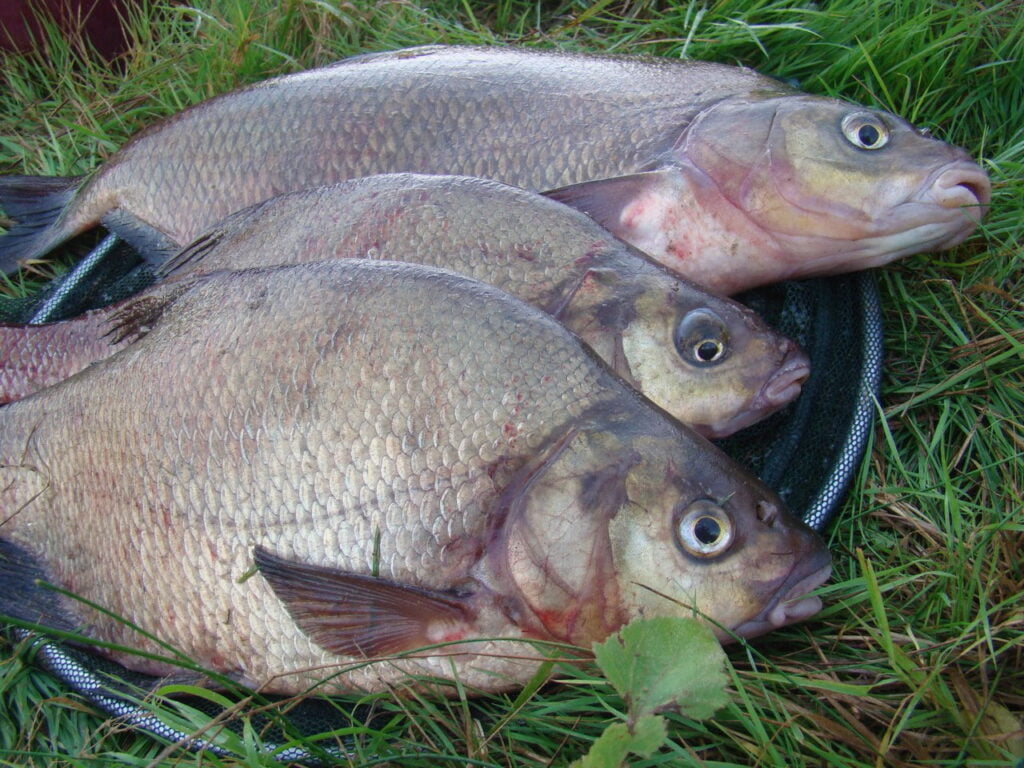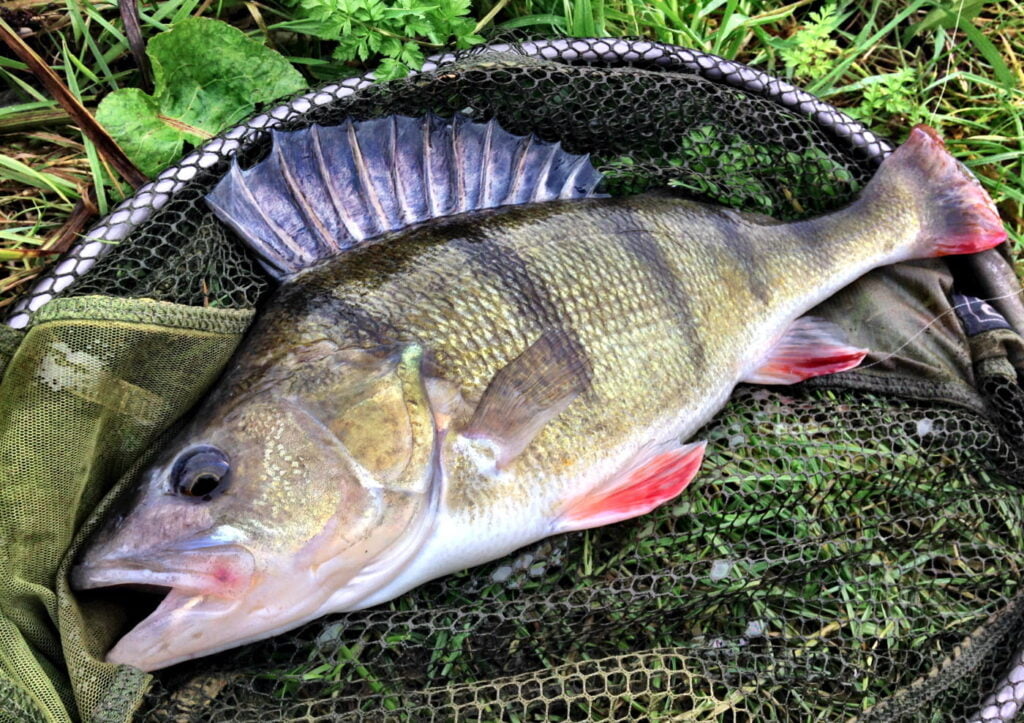Upėtakis – tai lašišinių šeimos žuvis, Lietuvoje laikoma vienu geidžiamiausių žūklės laimikių. Šis taškuotas plėšrūnas garsėja ne tik išskirtine išvaizda, bet ir kovingumu – pagautas atkakliai priešinasi, todėl žvejoti upėtakį įdomu ir azartiška. Toliau šiame straipsnyje apžvelgsime, kaip atrodo upėtakis, kuriose upėse Lietuvoje jis gyvena, kuo minta, kaip jį pagauti, kaip dauginasi, kokios galioja upėtakių žvejybos taisyklės bei kokios yra upėtakio kulinarinės savybės.
GERIAUSIOS RITĖS UPĖTAKIŲ ŽVEJYBAI
Kaip atrodo upėtakis
Upėtakis lengvai atpažįstamas iš savo taškuotos išvaizdos. Jo kūnas verpstiškas (į lašišą panašios formos), dengtas smulkiais žvyneliais. Nugara paprastai būna rusvai žalsva ar rudai pilka, šonai gelsvi, o visas kūnas nusėtas juodomis dėmelėmis. Tarp jų matyti ir ryškūs raudoni (oranžiniai) taškai su šviesiais apvadais. Pilvas upėtakio balkšvas ar pilkšvas. Toks margas taškelių raštas upėtakiui pelnė ir lietuvišką pavadinimą – margasis upėtakis. Beje, upėtakio spalva gali kisti priklausomai nuo aplinkos: skaidriuose upeliuose žuvis būna šviesesnė, o tamsesniuose vandenyse jos spalvos intensyvėja.
Dydžiu upėtakiai dažniausiai nėra labai dideli. Lietuvos upėse įprastai sugaunami 20–40 cm ilgio individai, sveriantys iki 1 kgl. Didesni nei 50 cm upėtakiai pasitaiko retai – tokie laimikiai laikomi itin stambiais. Teoriškai upėtakiai gali užaugti ir didesni (ežeruose ar tvenkiniuose kartais pasiekia ir ~80–90 cm bei kelis kilogramus, tačiau upeliuose tam pritrūksta maisto ir erdvės. Vis dėlto net ir nedidelis upėtakis pasižymi didele jėga ir veržlumu – ši žuvis yra labai stipri, judri ir atsargi. Dėl savo grakščios, taškuotos išvaizdos ir kovingo būdo upėtakis žvejų vertinamas ypatingai.
Upėtakis priskiriamas lašišinėms žuvims, todėl turi kai kurių bendrų bruožų su lašišomis ir šlakiais. Pavyzdžiui, jauni upėtakių ir šlakių individai būna panašūs (iki ~15 cm), tačiau užauga upėtakiai smulkesni už lašišas. Šlakiais vadinami tie patys upėtakiai, tik išplaukę į jūrą paaugti – ten jie tampa sidabriškesni, užauga iki 50–70 cm ar daugiau. Paprastai Lietuvos upėse sutinkame margąjį upėtakį – sėslų, upėse gyvenantį porūšį. Tai dėmėtoji žuvis, kurią supainioti su kitomis gėlavandenėmis beveik neįmanoma.

Kokiose upėse gyvena upėtakis Lietuvoje
Upėtakiams gyventi tinkamiausios yra šaltavandenės, švarios ir sraunios upės bei upeliai. Lietuvoje ši žuvis aptinkama daugelyje nedidelių upių aukštupių, ypač ten, kur gausu šaltinių, upės vaga akmenuota, o vanduo ištisus metus vėsus ir turtingas deguonies. Ne veltui sakoma, kad negražiose vietose upėtakių nėra – dažnai upėtakių galima rasti miškais apsuptuose upeliuose, vaizdingose ir nuošaliose vietovėse. Upėtakiai vengia šilto vandens, todėl vasarą jų reikia ieškoti ten, kur upės vėsios, o vaga gausiai maitinama požeminio vandens ir šaltinių.
Lietuvoje margieji upėtakiai gyvena daugiau nei 180 upių ir upelių – ši žuvis paplitusi net 11-os upių baseinuose. Gausiausios upėtakių populiacijos susitelkusios Nemuno baseino intakuose (nustatyta >20 intakų, kur gyvena upėtakiai), taip pat Neries (17 intakų) bei Merkio (16 intakai) baseinuose. Taip pat daug upėtakių aptinkama Žeimenos, Šventosios (Žeimenos/Neries), Minijos, Jūros (Akmenos) upių sistemose. Trumpai tariant, upėtakiai paplitę visoje Lietuvoje netolygiai – daugiausiai jų pietų ir rytų Lietuvoje (Dzūkijos, Aukštaitijos upeliuose) bei vakarų Lietuvoje (Žemaitijos upėse).
Verta paminėti, kad margasis upėtakis yra retas ir saugotinas. Natūralios jo nerštavietės (upelių atkarpos, kur žuvys dauginasi) yra saugomos įstatymų. Dėl jautrumo taršai upėtakiai išgyvena tik švariuose vandenyse, todėl ši rūšis nyksta ten, kur upės užteršiamos. Pastaruoju metu vykdant žuvivaisos programas, upėtakių populiacijos stiprinamos įveisimu (pvz., jauni upėtakiai dirbtinai veisiami ir išleidžiami į upelius). Vis dėlto žvejai dažnai laiko paslaptyje konkrečias upėtakių vietas – mažose upėse keli žvejai jau sudaro spaudimą, tad mėgėjai saugo pamėgtus ruožus. Upėtakiai dažniau aptinkami uždaresniuose upeliuose, kur nepatenka migruojantys šlakiai – užtvenktuose ar nuo didelių upių atskirtuose intakuose.
Kuo minta upėtakis
Upėtakis yra plėšri žuvis – jo racioną sudaro įvairūs mažesni gyvūnai. Jauni upėtakiukai iš pradžių minta smulkiais vandens bestuburiais: įvairiais vėžiagyviais ir vabzdžių lervomis. Paaugę ir suaugę upėtakiai tampa godžiais plėšrūnais, kurie ėda beveik viską, kas gyva ir telpa jiems į nasrus. Žemiau pateikiame upėtakio mitybos spektrą:
- Vabzdžiai. Upėtakiai gaudo tiek vandens vabzdžių lervas (lašalus, apsiuvus, uodų trūklių trūklio lervas ir kt.), tiek į vandenį įkritusius sausumos vabzdžius – muses, mašalus, vabalus, net žiogus. Vabzdžiai sudaro labai didelę raciono dalį, ypač vasarą.
- Vėžiagyviai. Jauni upėtakiai itin mėgsta mažus vėžiagyvius – pavyzdžiui, šoniplaukas, įvairius vandens vėžiukus. Taip pat gali paragauti ir vėžių jauniklius, jei tokių pasitaiko upelyje.
- Moliuskai. Suaugę upėtakiai nevengia pasmaguriauti mažomis sraigėmis ar midijų dvigeldžiais moliuskais. Jų stiprūs žandikauliai leidžia sutraiškyti minkštakūnių kiautus.
- Varliagyviai. Dideli upėtakiai kartais praryja ir mažas varlytes ar buožgalvius, jei tik pasitaiko proga. Tai nėra pagrindinis maistas, bet rodo upėtakio mitybos įvairumą.
- Žuvys. Tai tikri plėšrūnai, todėl subrendęs upėtakis medžioja ir smulkias žuveles. Upėse dažniausiai sudorojami gružliai, rainės, šapaliukai ar kitų rūšių mailius. Kai kurie stambesni egzemplioriai gali griebti net 10–15 cm ilgio aukšles ar kitą mažą žuvį.
Pastaba: upėtakiai visiškai neėda augalų – jiems nerūpi jokie dumbliai ar vandens žolės. Ši žuvis yra 100% mėsėdis. Esant labai plačiam maisto spektrui, upėtakiai paprastai maitinasi progai pasitaikius: stovi srovėje ir laukia, kol praplauks koks grobis. Taktika tokia: pastebėję grobį (vabzdį ar žuvelę) upėtakiai staigiu šuoliu atakuoja, griebia grobį net iššokdami iš vandens, tada grįžta į savo slėptuvę virškinti. Upėtakiai dažnai laikosi pasirinktoje vietoje (už akmens, duobėje po nuovirtusiu rąstu) – net išbaidytas upėtakis po kurio laiko grįžta atgal į pamėgtą plotą.
Kaip pagauti upėtakį
Upėtakių žvejyba – tikras iššūkis, reikalaujantis žinių ir kantrybės. Ši žuvis labai baikšti, tad priartėti prie jos reikia tyliai ir nepastebėtam. Žemiau pateikiame patarimus, padėsiančius padidinti sėkmę gaudant upėtakius Lietuvos upėse:
- Tylus priėjimas. Prisiminkite, kad upėtakis turi aštrią regą ir jaučia menkiausius virpesius. Prie upelio stenkitės eiti tyliai, slėpkitės už krūmų ar medžių, venkite savo šešėlio ant vandens. Geriausia prisiartinti einant prieš srovę, nes upėtakiai paprastai stovi atsisukę į srovę ir jūsų nepastebės. Kiekvienas triukšmas – traškantis šapelis po kojomis ar balsas – gali išbaidyti žuvį. Todėl judėkite lėtai, prisėlinę prie perspektyvaus ruožo, užmeskite masalą iš toliau.
- Masalai (masalų pasirinkimas). Lietuvoje upėtakiai gaudomi tik dirbtiniais masalais. Draudžiama naudoti gyvus masalus – sliekus, trūklių lervas, žuveles ar kitus gyvūnus ant kabliuko kabinti negalima (už tai gresia bauda ir įrankių konfiskavimas). Tad tenka rinktis dirbtinius masalus. Spiningaujant populiariausi yra maži vobleriai (3–6 cm ilgio) – jie imituoja mažas žuveles, būna įvairių spalvų ir plaukimo gylių. Taip pat veiksmingos blizgės. Muselinėje žūklėje masalų pasirinkimas dar platesnis: žiemą ir ankstyvą pavasarį efektyvūs strimeriai (pailgos muselės, imituojančios žuveles), vėliau – įvairios nimfos (vabzdžių lervų imitacijos), o šiltuoju metu laiku nepamainomos sausos muselės, kurias upėtakiai čiumpa paviršiuje. Svarbu parinkti masalą pagal tai, kuo tuo metu žuvys maitinasi – jei upėje daug smulkių žuvelių, tiks vobleris, jei matote vabzdžių skraidant, bandykite muselę ir pan.
- Įranga. Upėtakių žūklei rinkitės lengvą spiningą (ultralight arba light klasės) – ilgesnį (~1.8–2.4 m) kotą, kad patogiau būtų mesti masalą po šakomis, ir ploną, tvirtą valą (monofilamentą arba pintą). Masalai maži, todėl svarbu, kad įrankiai būtų jautrūs – taip pajusite kibimą akimirksniu.
- Kada ir kur ieškoti. Žiemos metu ir ankstyvą pavasarį upėtakiai laikosi gilesnėse duobėse, užuovėjose, kur lėtesnė srovė – ten vanduo šiltesnis. Dažnai žuvys tūno prie kliuvinių: įvirtusių šakų, stambių akmenų, po kuriais mažesnė srovė. Vasarai įsibėgėjus, upėtakiai suaktyvėja rytiniais ir vakariniais prieblandos momentais, kai vanduo atvėsta. Tada jų ieškokite srauniose rėvose ties srovės ir lėtesnio vandens sandūra – upėtakiai mėgsta stovėti už akmens ar užvartų, kur ramiau, ir laukti atnešamo maisto. Dieną per kaitrą jie dažnai slepiasi po žolėmis, po akmenimis. Lyjant ar vos pakilus vandeniui, upėtakiai drąsesni – gaudo išplaunamus sliekus, vabzdžius.
Žvejojant upėtakius svarbu būti kantriam. Dažnai tenka nueiti kilometrus upelio pakrante, kol surandi tinkamą užutekį ar duburį, kuriame stovi žuvis. Tačiau pastangos atsiperka – upėtakio kibimas ir kova teikia išskirtinį malonumą. Laikantis taisyklių ir taikant tinkamas technikas, Lietuvos upeliuose galima sėkmingai sugauti gražių margųjų upėtakių. Svarbiausia – gerbti gamtą ir paleisti sugautas žuvis, nes to reikalauja įstatymai. Apie tai – kitame skyriuje.
Upėtakių žvejybos taisyklės
Pagautas upėtakis nedelsiant paleidžiamas atgal į upę – Lietuvoje galioja griežta pagavai-paleisk tvarka.
Upėtakių apsauga Lietuvoje yra prioritetinė, todėl žvejybos taisyklės gana griežtos. Pagrindiniai reikalavimai žvejojant marguosius upėtakius:
- Sezonas. Draudžiamas upėtakių gaudymas nuo spalio 1 d. iki gruodžio 31 d. – tai upėtakių neršto laikotarpis, tad žvejyba šiuo metu negalima. Sezonas prasideda sausio 1 d. ir tęsiasi iki rugsėjo 30 d. imtinai. Kai kuriuose upeliuose (nerštavietėse) per nerštą draudžiama bet kokia žvejyba apskritai, siekiant visiškai apsaugoti neršiančias žuvis.
- Masalų apribojimai. Upėtakius leidžiama gaudyti tik dirbtiniais masalais. Pagal taisykles draudžiama žvejoti gyvąja žuvele, slieku, vabzdžių lervomis ar kitais natūraliais masalais. Šis draudimas galioja būtent margųjų upėtakių žvejybai upėse – už pažeidimą gresia administracinė atsakomybė (baudos, žvejybos įrankių konfiskavimas). Taigi, spiningauti galima tik su blizgėmis, vobleriais ir pan., o museliauti – tik su dirbtinėmis muselėmis.
- Sugavimo limitai. Nuo 2024 m. įsigaliojo “pagavai–paleisk” principas: visuose Lietuvos upeliuose sugautus upėtakius privaloma nedelsiant paleisti atgal. Tai reiškia, kad bendras leidžiamas paimti upėtakių kiekis – 0. Anksčiau mėgėjai galėdavo pasiimti 2–3 upėtakius per dieną, jei jie atitiko dydžio reikalavimus, tačiau dabar, siekiant atkurti populiaciją, laimikliai turi būti paleidžiami. Išimtis taikoma tik vienai vietai: Merkio upės ruože aukščiau Ožkelaičių tilto. Ten organizuota limituota žvejyba – įsigijus specialią žvejo mėgėjo kortelę, per vieną žvejybą leidžiama pasiimti ne daugiau dviejų upėtakių. Tie upėtakiai privalo būti ne mažesni nei 30 cm ir ne didesni nei 40 cm ilgio. Kitose upėse minimalaus dydžio reikalavimas (30 cm) išlieka, bet praktiškai visi sugauti margieji upėtakiai turi būti paleidžiami.
- Kitos taisyklės. Saugotinos upėtakio buveinės (pvz., nedideli upeliai) reikalauja atsakingo elgesio: negalima bristi ir mindžioti nerštaviečių neršto metu, nešiukšlinti, netrikdyti aplinkos. Laikantis šių taisyklių, užtikrinama, kad upėtakių ištekliai atsikurs ir bus prieinami ateities žvejams.
Apibendrintai – Lietuvoje margasis upėtakis dabar yra saugomas, todėl pagrindinė žinutė žvejams: pagavai – paleisk. Tai leis šioms tauriosioms žuvims atsigauti. Prieš vykdami žvejoti, visada pasitikrinkite galiojančias taisykles (jos kartais atnaujinamos), kad išvengtumėte netyčinių pažeidimų.
Upėtakio kulinarinės savybės
Upėtakis vertinamas ne tik kaip sportinis laimikis, bet ir kaip gurmaniška žuvis. Jo mėsa yra švelni, saikingai riebi ir neturi intensyvaus „žuvies“ kvapo. Dėl natūralios mitybos švariuose vandenyse upėtakio skonis subtilus, tekstūra tvirta – tiesiog tirpsta burnoje. Be to, upėtakyje beveik nėra smulkių ašakų, todėl jį lengva išdarinėti ir valgyti net vaikams. Labai vertinama ir tai, kad upėtakis užaugęs natūraliai neturi sukaupęs sunkiųjų metalų ar toksinų – ši žuvis tiesiog neišgyvena nešvariuose vandenyse, todėl jos mėsa yra švari ir sveika. Ne veltui upėtakis laikomas viena sveikiausių žuvų.
Upėtakio maistinė vertė
Upėtakio mėsa pasižymi didele maistine verte. Joje gausu visaverčių baltymų, vitaminų ir mikroelementų. Štai 100 g upėtakio (žalios žuvies) vidutiniškai yra apie 150 kcal, apie 18–20 g baltymų ir ~10 g riebalų. Upėtakyje sukaupta nemažai omega-3 riebalų rūgščių, kurios svarbios širdies ir kraujagyslių sveikatai. Taip pat ši žuvis išsiskiria dideliu kalcio kiekiu – turi apie 25 mg/100g, tai net 3 kartus daugiau nei lašišos mėsoje. Upėtakis turtingas vitaminu D, kurio stokoja daugelis mūsų (ypač po žiemos), taip pat vitaminais B12, A ir kitais B grupės vitaminais. Reguliarus upėtakio vartojimas gali pagerinti imunitetą (dėl omega-3 poveikio), prisidėti prie kaulų tvirtumo (dėl kalcio ir vitamino D), stiprinti nervų sistemą (dėl B12 gausos). Tai lengvai virškinama žuvis, tinkanti net tiems, kas turi jautresnį skrandį. Žemiau pateikiama upėtakio maistingumo santrauka:
| Maistinė medžiaga (100 g) | Kiekis | Palyginimas/nauda |
|---|---|---|
| Kalorijos | ~150 kcal | (palyginti liesa žuvis) |
| Baltymai | ~20 g | Aukštos kokybės baltymai |
| Riebalai | ~9–10 g | Iš jų gausu omega-3 rūgščių |
| Kalcis | ~25 mg | ~3× daugiau nei lašišoje |
| Vitaminai | D, B₁₂, A ir kt. | Daug vit. D (stiprina kaulus), B₁₂ (net 7× daugiau nei lašišoje) |
Upėtakio paruošimas
Upėtakio mėsa universali – tinka įvairiems patiekalams. Lietuvoje labai populiarus šviežias vaivorykštinis upėtakis (dažnai ūkiuose užaugintas) – jį galima nesunkiai įsigyti parduotuvėse ištisus metus. Iš upėtakio gaminami skanūs patiekalai tiek kasdienai, tiek šventėms. Keletas patarimų kaip geriausia paruošti upėtakį:
- Kepimas orkaitėje. Išvalytą upėtakį galima įdaryti citrina, sviestu, žolelėmis (krapais, petražolėmis), apibarstyti prieskoniais (druska, pipirais) ir suvynioti į foliją. Kepti ~180°C orkaitėje ~20–30 min (priklausomai nuo dydžio). Žuvis iškepa sultinga, įgauna lengvą žolelių aromatą.
- Kepimas ant grotelių. Upėtakio filė ar kepsnelius (steikus) skanu kepti ant griliaus. Ištepkite aliejumi, pabarstykite mėgstamais prieskoniais (pvz., citrinpipiriais) ir kepkite ant įkaitusių grotelių ~5 min iš kiekvienos pusės, kol mėsa lengvai atsiskirs. Taip paruoštas upėtakis įgauna dūmo aromatą, išlieka sultingas.
- Rūkymas. Labai mėgstamas rūkyto upėtakio skonis. Galima rūkyti tiek karštu būdu ( ~2–3 val. ~80°C temperatūroje), tiek šaltu būdu (ilgesnį laiką <30°C dūmuose). Prieš rūkymą žuvį rekomenduojama ~6–8 val. pamarinuoti druskos, cukraus ir prieskonių mišinyje. Išrūkyta upėtakio mėsa būna rausva, kvapni, puikiai tinka užkandžiams ar salotoms.
- Troškinimas ir virimas. Upėtakis taip pat tinka žuvienei virti (ypač galva, kaulai – suteikia sultiniui gerą skonį). Filė gabaliukus galima troškinti grietinėlės padaže arba garuose su daržovėmis – gaunamas dietinis, lengvas patiekalas.
Upėtakio patiekalai pasižymi švelniu skoniu, todėl svarbu jų neperkepti – kepti iki kol mėsa vos vos ima slinkti sluoksniais. Patiekiant tinka citrinos griežinėlis, nes rūgštelė paryškina skonį. Garnyrui dera šviežios salotos, keptos bulvės ar sezoninės daržovės. Tradicinėje virtuvėje upėtakis dažnai ruošiamas panašiai kaip lašiša, tačiau jo skonis subtilesnis. Dėl nedidelio ašakų kiekio upėtakį lengva filėruoti – išėmus centrinį kaulą, beveik nebelieka smulkių kauliukų.Tai labai patogu, ypač ruošiant vaikams.
Apibendrinant, upėtakis – vertinga ir gardi žuvis. Jo žvejyba teikia malonumą, o sugautas (ar įsigytas) upėtakis gali virsti puikia vakariene. Laikantis žvejybos taisyklių ir tausojant populiaciją, galėsime džiaugtis upėtakiais Lietuvos upėse ir ateityje. Skaniai paruoštas upėtakis – tikras delikatesas, turtingas naudingų medžiagų ir nepakartojamo skonio. Ne veltui upėtakiai vadinami tauriausiomis mūsų vandenų žuvimis – jie džiugina ir žvejo meistriškumą, ir gurmano skonio receptorius.











